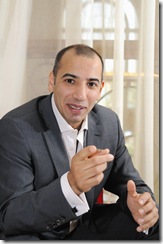Currently, there are over 500 million users of wireless broadband technology worldwide and usage is growing at a phenomenal rate. In this region we know that consumers in general are very early adopters of any type of technology and so we see very good broadband growth potential. When you look at any of the operators in any of the key markets in the Gulf, they are amongst the first in the world to trial LTE. So we really see LTE as being very strong in the region.
We all know that in this market people love technology and gadgets; they want fast speeds and connectivity everywhere. We can see this with the number of smart devices, Android phones, and iPhones that seem to be taking root here as well as devices like the iPad.
Ray Hassan is president and head of customer unit GCC, Ericsson Middle East
Moreover, 3G is already rolled out across most of the Gulf. When it comes to mobile broadband technology and mobile Internet, we are finding that a lot of consumers are demanding LTE, faster and faster data and more and more sophisticated applications from the operators. So, the operators are only fulfilling the demand that seems to be coming from their customers.
Some of the reasons that are driving mobile broadband stem from the instant access to information that people now demand. They don’t want to go home or get inside a building to get fixed access. They want it on the move. Mobility is very important. At the same time a number of things are happening; the devices are becoming more affordable, and there are great applications for devices being developed daily – whether you look at the iPhone or now the Android systems. Also, in this region people are becoming much more ‘smart’ in terms of their technology use. People of all ages seem to be becoming more tech-savvy compared to elsewhere in the world, and children are also driving the usage, parents are encouraging children and affordability is another aspect of that.
People are beginning to forego the fixed Internet and are moving straight to mobile broadband.
Most of the operators in the Gulf are testing these facilities individually and independently. There are at least five or six ongoing LTE trials at the moment. In one of the trials that we are conducting in Saudi Arabia, we see phenomenal throughput (data speeds) coming through. In fact, Ericsson’s equipment was the fastest of all LTE equipment trials by the operators there.
The demand for mobile data access is fuelling a lot of the devices and the technology that are coming. People just want more. That is natural. I remember a time when we were used to not having coverage in lifts or basements. We don’t accept call breaks.
The expectations of consumers and users worldwide have grown. Nowadays, they also expect that they should be able to do everything they can do on a fixed device at home, on their mobile and so much more. The more numerous and better the applications become, the more demand there is for even better applications and products. A lot of devices including the Google Android operating system, which is an open access platform, are fuelling this growth. You can download free applications on it, so that usage is higher, and so not only are more operators keen to introduce it, but also thousands of developers all over the world are focusing on it.
Devices such as the iPad and new phones will also result in further data demand; as they encourage people to take the full benefit of mobility and this will naturally result in LTE being introduced very quickly into the region.
In terms of technological competitors to LTE in the Gulf, we don’t even see WiMAX as one. HSPA is probably a better comparison. Now HSPA is faster than WiMAX. In 2008-2009, HSPA had the same data throughputs as WiMAX has. Plus LTE has true mobility which WiMAX does not have. HSPA+ exceeded the capabilities of WiMAX and to be fair LTE is in a completely different class.
We see LTE as the undisputed choice. Most countries and most operators and certainly many of the equipment vendors have moved away from WiMAX even when they are doing trials with commercial launches. There are trials beginning to build LTE networks. Other equipment vendors announced that they are moving towards LTE and away from WiMAX. 
Mobile subscribers in the GCC are known to be technology savvy, and operators in the region are upgrading and optimising networks to keep pace with the rapid growth in demand for mobile broadband
We see that those organisations that made the decision to deploy WiMAX will continue with it and move out of it pretty quickly. We don’t see it scaling and we don’t see many devices available. And certainly there is no mobility available. We expect that people will just move over to LTE as quickly as possible. We don’t see it continuing much longer. With LTE becoming more and more affordable, we don’t see that deploying WiMAX at a large scale is something that will continue.
In some perspective it is no different than the various standards and phones that used to be used in the US, GSM was the global technology and most people follow whatever will give you access globally. LTE has become the norm and the standard for the future of all operators in the region.
Ericsson has aligned its product portfolio specifically to ensure smooth transition from 3G to 4G and thus protect the investments our customers make.
We have worked very hard in standardising our platforms and also to address some of the sustainability aspects primarily. We have a product family called the RBS 6000. That is a single platform access base stations that allows you to plug in all technology – 2G, 3G, HSPA and LTE. This is the smallest RBS device in the market and despite being technically very advanced with better sensitivity and coverage it uses much less power. Operators are already upgrading their 2G and 3G networks replacing them with the RBS 6000 because of the lower power and also because it allows seamless upgrades to LTE. It basically requires no new hardware. Just with the software we can remotely change the networks from 2G to 3G, to mobile broadband and LTE. Many operators are at a bursting point already with the amount of data demand. Consumer appetite for data does not seem to be falling; it is in fact growing exponentially. Networks are being upgraded as we speak, at a much faster rate than in 2009 when many operators were just reviewing their expenditure. This year, operators are upgrading their networks, mostly with LTE components. So, we expect transition to LTE to be much faster than any other previous technology.
We expect Ericsson as a key driver of technology and as a key driver of faster throughput, to help drive the increased usage of mobile broadband everywhere.
Ray Hassan is president and head of customer unit GCC, Ericsson Middle East





0 comments ↓
There are no comments yet...Kick things off by filling out the form below.
Leave a Comment